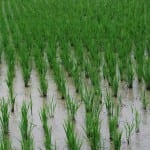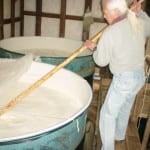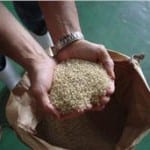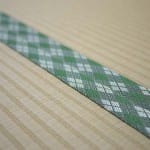 Have you ever looked over a golden brocade of ready-for-harvest rice andand wonder how many bottles of sake could be made from it? Maybe not. Regardless, it is not an easy question to answer, because there are so many variables involved.
Have you ever looked over a golden brocade of ready-for-harvest rice andand wonder how many bottles of sake could be made from it? Maybe not. Regardless, it is not an easy question to answer, because there are so many variables involved.
The first of these variables is the typical yields a given strain of rice will provide versus another. Some varieties might yield only 450 kilograms of rice per hundred-square meters, whereas another might yields as much as 600 kg or more. That alone is a 33 percent difference.
Next consider milling. If a sake is made with rice milled down to only 88 percent, i.e. discarding but 22 percent of the rice, it has a big-ass head start on yields over a sake made with rice milled down to 35 percent, wherein 65 percent of the raw material is cast aside.
Then there are the steps of the brewing process. For example, how far is fermentation allowed to proceed? Fermenting until every last starch molecule has been converted to sugar, and that subsequently to alcohol, will lead to much more sake for a given amount of rice than stopping fermentation earlier. Furthermore, we need to ask how hard was the fermenting mash compressed to squeeze out the resulting sake after fermentation.
 Fermenting further and pressing it harder will lead to more sake! But fermenting to the bitter end and then squeezing out every last drop of yield takes a huge toll on quality. Also, whether or not alcohol is added – and if added, how much – has a huge affect well. Yields for cheap sake in which copious amounts of alcohol are added can be double what they are for premium sake.
Fermenting further and pressing it harder will lead to more sake! But fermenting to the bitter end and then squeezing out every last drop of yield takes a huge toll on quality. Also, whether or not alcohol is added – and if added, how much – has a huge affect well. Yields for cheap sake in which copious amounts of alcohol are added can be double what they are for premium sake.
With all this compounding error, it is very difficult to say how much sake can be brewed from, say, a ton of rice. Still, it’s an interesting question. So let’s see . . .
To do this, we have to set up a few boundary conditions. Let’s say the size of the batch is one metric ton of rice, and that we are brewing junmaishu, so no alcohol has been added. Let’s also say that the seimai-buai is 60 percent, so that the outer 40 percent of the rice has been ground away.
Finally, let’s assume (huge jump in the analytic process here) that the moromi (the fermenting mash, one ton of rice) was allowed to ferment to the extent that, when the sake was separated from the leftover rice solids, there were 2200 bottles of sake. (A number supplied by a brewer as typical.)
Now, on to the land. Rice is sold by farmers in 60-kg units called hyo. A basic unit of farming land is 10 meters by 100 meters, and is known as a tan.
Since every rice strain is different, and since things vary from place to place due to weather conditions, we are starting to compound errors again. But for much good sake rice, like Yamada Nishiki, one tan yields eight hyo of rice. (Got that?) In other words, you can get about 480 kg of Yamada Nishiki from a plot of land ten meters by one hundred meters.
But wait! Keep in mind that this is brown rice, and we are using rice milled to 60 percent. So, to get one ton of our polished rice, we need to start with 1.66 tons of brown rice.
 Firing up the calculator again, we see that we need about 3.5 tan to yield the 1.66 tons of brown rice. So, in the end, an area of 35 x 100 meters (about the size of a football field) will yield about 2,200 wine-bottle-size bottles of sake. But note that this is genshu, i.e. undiluted. So adding a bit of water to lower the alcohol content from 18 or 19 down to 15 or 16 will bring it to about 2500 bottles of sake, 720 ml each, from our one ton of polished rice that came from a field the size of a football field. About.
Firing up the calculator again, we see that we need about 3.5 tan to yield the 1.66 tons of brown rice. So, in the end, an area of 35 x 100 meters (about the size of a football field) will yield about 2,200 wine-bottle-size bottles of sake. But note that this is genshu, i.e. undiluted. So adding a bit of water to lower the alcohol content from 18 or 19 down to 15 or 16 will bring it to about 2500 bottles of sake, 720 ml each, from our one ton of polished rice that came from a field the size of a football field. About.
Please allow me to reiterate that the assumed degrees of accuracy throughout these calculations is appalling from an engineering standpoint. But still, it’s kind of neat to be able to glance out over a golden field of rice, and think, “Now let’s see . . .”
* * * * * * * * *
 For those that are interested, rice fields in Japan are measured in traditional units of area with unique names. And they are very close to metric measurements. Interestingly, this ties in to room measurement sizes, which in turn ties into tatami mat sizes.
For those that are interested, rice fields in Japan are measured in traditional units of area with unique names. And they are very close to metric measurements. Interestingly, this ties in to room measurement sizes, which in turn ties into tatami mat sizes.
Two tatami mats together measure 3.3058 square meters.
 This unit is one tsubo. Three hundred tsubo is (300 x 3.3058) about 1000 square meters, which is also equal to one tan (10m x 100m). Ten tan, or a 100 x 100-meter plot, make up one cho. One cho is very close to one hectare. LIke, within one percent. Now you know.
This unit is one tsubo. Three hundred tsubo is (300 x 3.3058) about 1000 square meters, which is also equal to one tan (10m x 100m). Ten tan, or a 100 x 100-meter plot, make up one cho. One cho is very close to one hectare. LIke, within one percent. Now you know.
************
 The next Sake Professional Course will take place in San Francisco on December 8 to 10. Learn more here.
The next Sake Professional Course will take place in San Francisco on December 8 to 10. Learn more here.
Meanwhile, the next Sake Professional Course in Japan will take place January 26 to 30, 2015. Learn more here.
Feel free to email me with questions about either!




